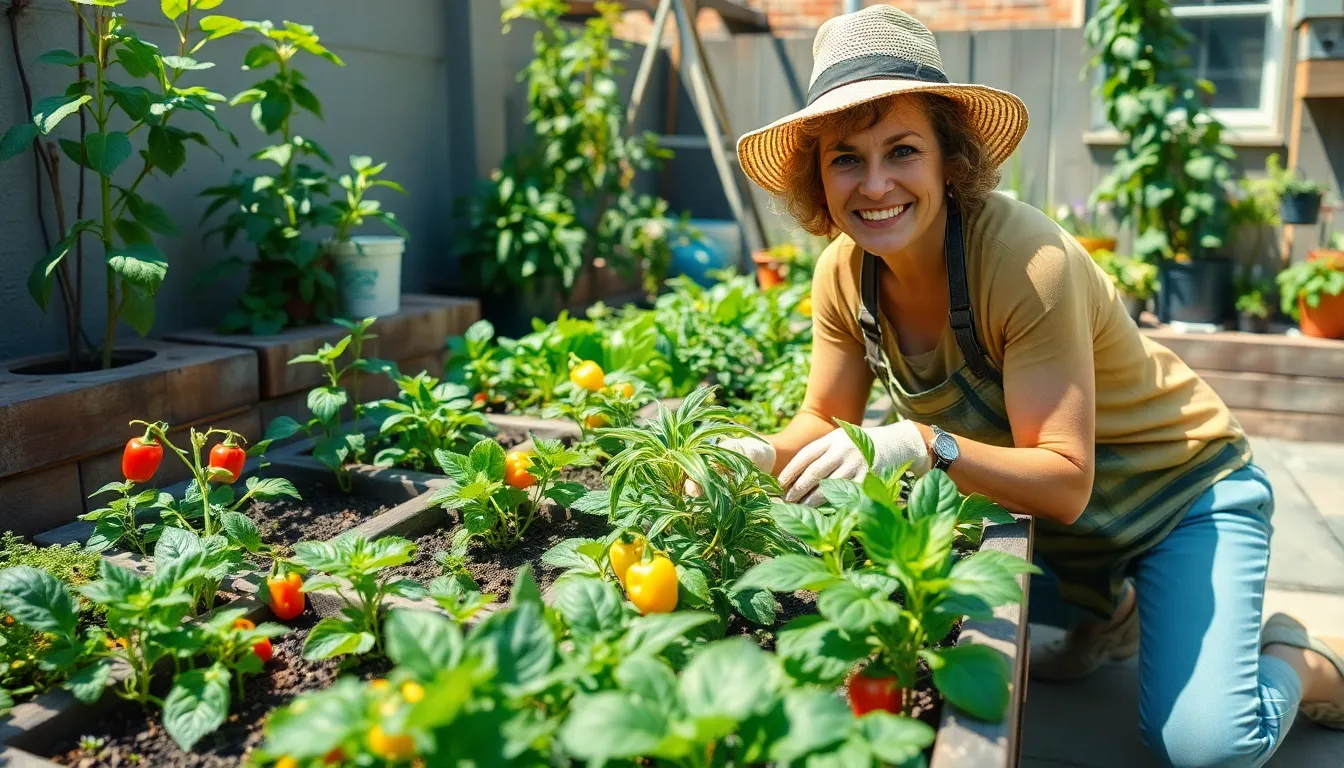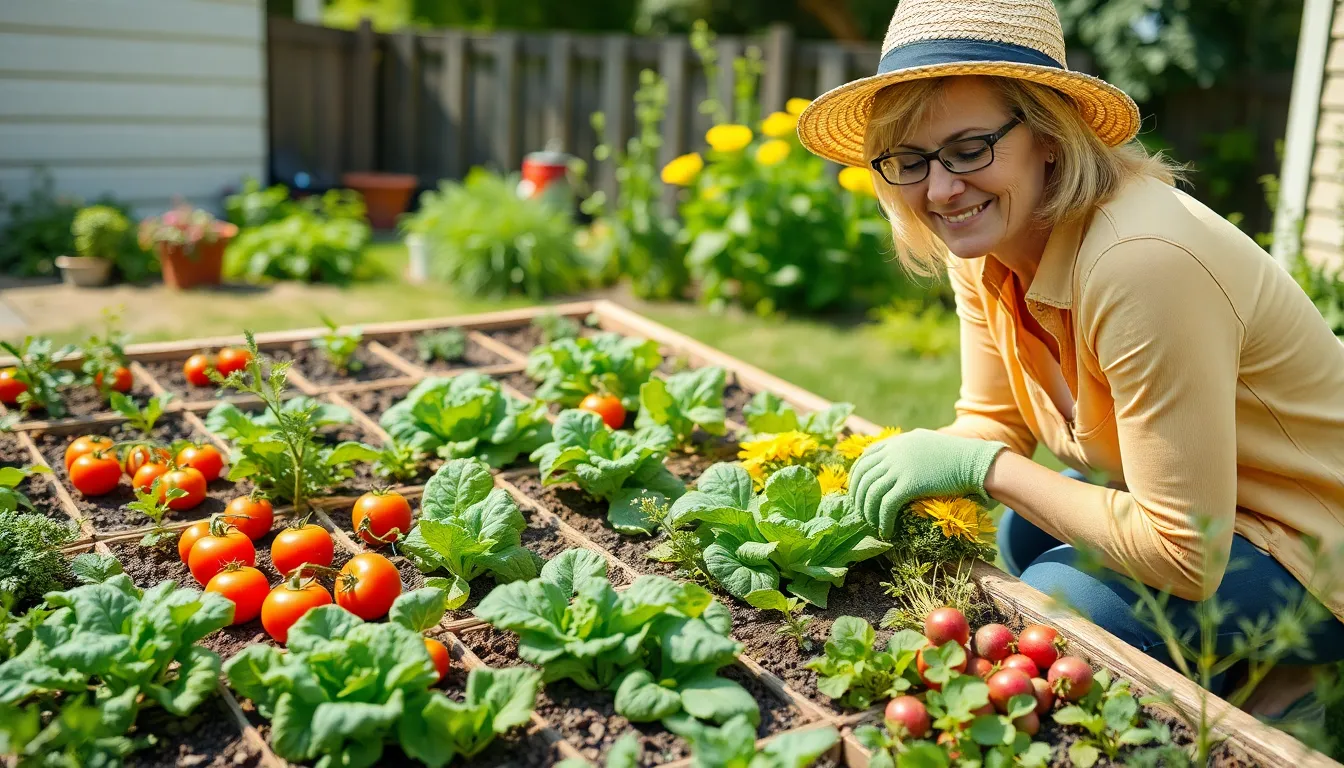Imagine transforming a tiny patch of dirt into a lush, bountiful garden that could make even the most seasoned farmer green with envy. Square foot gardening isn’t just a trend; it’s a smart, efficient way to grow your own food, no matter how much space you’ve got. With its simple grid system, this method maximizes productivity while minimizing the back-breaking labor typically associated with traditional gardening.
Table of Contents
ToggleWhat Is Square Foot Gardening?
Square foot gardening represents a compact gardening method designed for maximizing crop yield while minimizing space usage. This technique divides a garden into square sections, typically measuring one foot by one foot, allowing for efficient planting of various crops. A grid system guides gardeners in arranging plants according to their growth habits and space requirements.
Optimal planting patterns increase density without overcrowding. For instance, a square can accommodate one large plant like a tomato or multiple smaller plants such as radishes. This arrangement promotes better air circulation and sunlight exposure, fostering healthier growth.
Gardeners using this method can adapt it to various environments, including urban settings. Raised beds often enhance soil quality and drainage, crucial for plant health. Users find that these elevated beds simplify maintenance tasks like weeding and harvesting.
Those interested in square foot gardening benefit from precise planning. Calculating plant spacing based on each variety’s needs allows for a diverse array of crops within a limited area. For example, a 4×4 foot garden can yield up to 16 different types of vegetables, depending on the gardener’s choices.
This approach not only supports sustainable gardening practices but also encourages individuals to grow their food at home. It reduces dependence on store-bought produce, offering fresher and more nutritious options. Enthusiasts of this method often express satisfaction with its productivity and ease of use.
Benefits of Square Foot Gardening

Square foot gardening offers several advantages, making it a popular choice for both novice and experienced gardeners.
Space Efficiency
Space efficiency stands out as a primary benefit of square foot gardening. By dividing the garden into square sections, typically one foot by one foot, gardeners optimize the use of limited space. This method allows for different crops to thrive in close proximity. For example, almost 16 plant varieties can fit into a 4×4 foot garden. Urban dwellers especially appreciate this technique since they can create productive gardens on balconies or small yards. Less traditional space is necessary, enabling more people to engage in gardening, regardless of where they live.
Improved Yields
Improved yields represent another significant advantage. The grid system encourages dense planting, which often results in higher productivity compared to conventional gardening methods. Gardeners can incorporate a mix of crops that utilize vertical space. For instance, vining plants can grow alongside shorter ones, maximizing available sunlight and resource sharing. Research indicates that square foot gardening may yield 100% more crops in the same area compared to row gardening. This method not only increases the quantity of produce but also enhances the diversity of vegetables available for harvest.
How to Set Up Your Square Foot Garden
Setting up a square foot garden involves careful consideration of location, soil preparation, and grid design. Each step directly influences the garden’s productivity.
Choosing the Right Location
Selecting an optimal spot is essential for square foot gardening. Full sunlight for at least six hours daily promotes healthy plant growth. Nearby water sources facilitate easy watering routines. Accessibility simplifies maintenance tasks like harvesting and weeding. Avoid areas prone to strong winds or heavy shade, as these conditions can inhibit growth.
Soil Preparation and Mix
Preparing high-quality soil is crucial for maximizing yields. A blend of one-third compost, one-third peat moss, and one-third vermiculite creates an ideal mix. This combination enhances soil fertility and ensures good drainage. Testing the pH level helps tailor soil amendments, ensuring suitability for specific plants. Properly aerated soil promotes healthy root development and effective moisture retention.
Designing the Grid
Designing an efficient grid system streamlines planting efforts. Marking off a square foot section helps gardeners visualize spacing needs. Each section can host varying crops based on their size and growth habits. For instance, placing four radishes in one square encourages dense planting. Utilizing durable materials like wood or string assists in maintaining grid structure. Regularly adjusting the grid layout based on seasonal crops enhances garden productivity.
Plants Suitable for Square Foot Gardening
Diverse crops thrive in square foot gardening, making it a flexible choice. Vegetables like lettuce and spinach grow well, requiring minimal space and allowing for multiple plantings throughout the season. Carrots and radishes also fit neatly in this structure, as they mature quickly and can be sown in succession.
For those who prefer larger plants, tomatoes, peppers, and eggplants show great compatibility with this method. Each of these plants benefits from ample sun exposure while still fitting within the grid layout. Squash varieties, including zucchini, occupy more space and should be planted sparingly.
Herbs like basil, cilantro, and parsley maximize garden efficiency, as they can be interplanted within squares. Companion planting enhances these options, as some herbs deter pests from nearby vegetables.
Additionally, beans, peas, and cucumbers serve well in vertical spaces, allowing for productive use of garden height. This upward growth pattern increases overall yield without consuming too much ground space.
Finally, salad greens, including arugula and kale, adapt perfectly to square foot setups. These greens are harvestable multiple times, doubling or tripling yields in smaller plots.
Farmers and home gardeners alike benefit from choosing crops tailored to their local climate and growth conditions. Understanding specific plant requirements aids in creating a flourishing, diverse square foot garden that maximizes productivity and enjoyment.
Maintenance Tips for Square Foot Gardens
Regular maintenance of square foot gardens ensures optimal growth and productivity. Watering consistently keeps plants hydrated, with approximately one inch of water weekly being ideal. Mulching around plants helps retain moisture and minimize weeds while improving soil health.
Weeding requires attention; addressing weeds promptly prevents them from competing with crops. Hand weeding often suffices in small spaces, ensuring root systems remain undisturbed. Crop rotation protects soil nutrients and reduces disease risk by alternating plant families in each section annually.
Fertilization supports vigorous plant growth. Organic fertilizers should be added as needed, typically every four to six weeks during the growing season. Compost also enriches the soil, providing essential nutrients and improving its structure.
Pest control methods vary, with integrated pest management being effective. Using beneficial insects, like ladybugs and lacewings, can help manage harmful pests naturally. Additionally, applying organic insecticidal soap tackles insect issues without harming the environment.
Observation plays a crucial role in garden health. Checking plants regularly allows gardeners to spot problems early. Addressing nutrient deficiencies, pest infestations, or diseases promptly prevents larger issues down the line.
Seasonal adjustments optimize garden performance. In colder months, protective covers can shield plants from frost. During peak growing seasons, adjusting irrigation and pruning plants for better airflow enhances overall productivity.
By following these maintenance tips, square foot gardens thrive, producing bountiful, healthy crops year after year.
Square foot gardening offers a practical and efficient way to grow food in any space. Its innovative design maximizes yields while minimizing the effort needed for maintenance. By adopting this method, gardeners can enjoy a bountiful harvest of diverse crops, all while contributing to sustainable practices.
Whether in urban settings or backyards, this technique empowers individuals to take control of their food sources. With careful planning and attention to plant needs, anyone can cultivate a thriving garden that provides fresh produce year-round. Embracing square foot gardening not only enhances personal well-being but also fosters a deeper connection to the environment.



